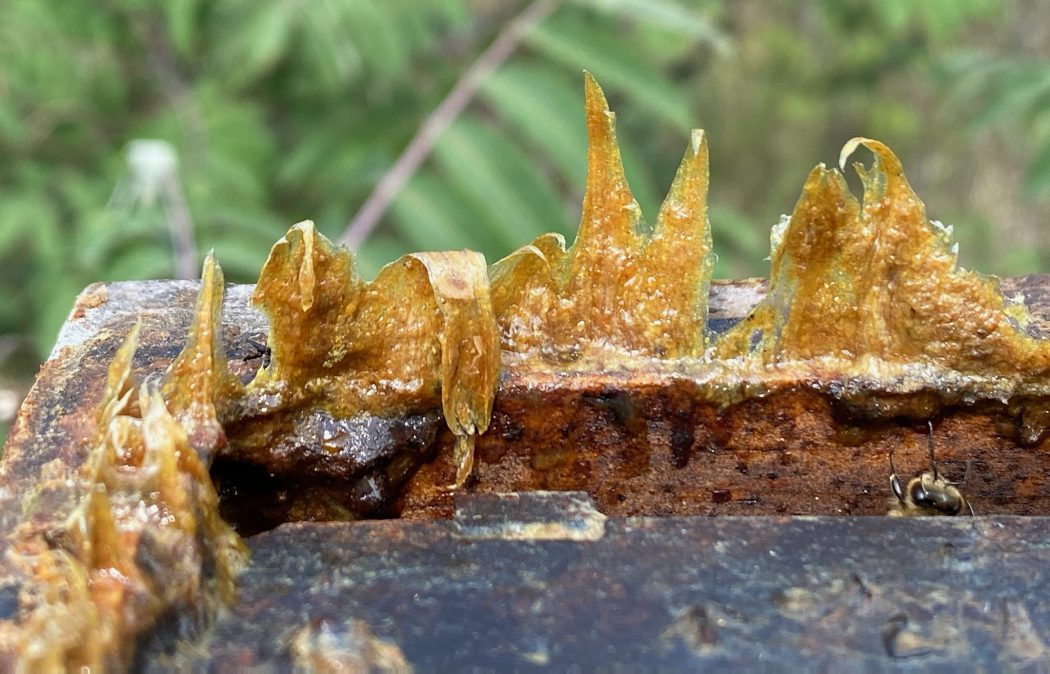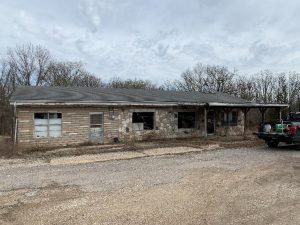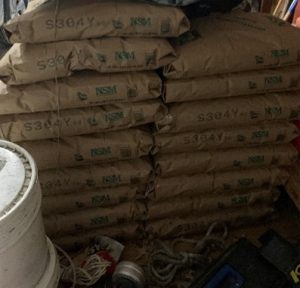Propolis 10 Ways
By: Becky Masterman & Bridget Mendel
What is propolis? Etymologically, propolis derives from the Greek for “before the city” (pro=before, polis= city or community). Entomologically, propolis is derived by bees (honey bees and stingless bees) from plant resins, mixed with beeswax and enzymes (and possibly other things) and cemented around the bees’ nest cavity.
Propolis has seemingly endless beneficial properties for humans and bees. A plebian might call it a magic potion and leave it at that. But for scientists, propolis is uniquely challenging to study. While propolis is antifungal, antiviral, antibacterial, anti-inflammatory, antioxidant and even anticancer, it is also antistandardized. Okay we made the last word up (Lizzo says we can). But what we are getting at is that propolis has different properties and actions depending on the source of the plant resin. Components of propolis have numbered over 300 and standardizing propolis based on plant source would be needed to support repeatable results when harnessing the power of this natural, but complex substance (Sforcin 2016).
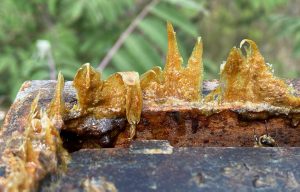
When this hive was pried open, it revealed a thick layer of propolis between the boxes. Photo credit: Judy Griesedieck
And propolis means different things to different beings:
If you are a honey bee…
Propolis is the substance you collect from the leaf buds of trees, plastering it into the cracks and crevices of your nest cavity. You use propolis as a form of social healthcare; this antimicrobial substance helps you and your sisters to stay healthy collectively. With propolis around the home, your immune system can rest up, ready to kick into high gear if needed (Simone et al. 2009, Borba et al. 2015).
If you are a stingless bee…
If you are a stingless bee, you have many uses for plant resins in the hive. Stingless bee management, or meliponiculture, is practiced for the production of honey and hive resin products, including propolis, as well as pollination (Cortopassi-Laurino et al. 2006). A recent review by Shanahan and Spivak (2021) provides insight into the complexity of resin use in this diverse and populous (over 500 described species!) group.
If you are a beekeeper…
If you are a beekeeper, propolis is why you keep a little old crowbar in your back pocket. Propolis is like cement, it stains your clothes forever, gets under your fingernails, and turns your palms orange-green-yellow. Some beekeepers have allergies to certain types of propolis. Ah, the things we tolerate for the sake of our bees.
If you are a cottonwood tree…
If you are a cottonwood tree, or a poplar tree for that matter, propolis is just a pretentious word for resin. It’s like how a very thin piece of ham is called prosciutto just because it is cured and expertly sliced?? It’s unclear if honey bees cure or otherwise tamper with the medicinal resins they collect from the leaf buds of trees, but essentially it is the same substance, give or take some enzymes. If you are a tree, you produce resin to protect yourself from insects and pathogens.
A drug developer or medicine maker…
If you are in the business of medicine making, you are acquainted with the numerous biological activities of propolis reported by researchers. Herbalists have been using propolis for wound dressing and oral health since King Nyuserre reigned Egypt (Hammad 2018). More clinical work needs to be done in order to understand and further harness the potential of propolis for human health (Silva-Carvalho et al. 2015).
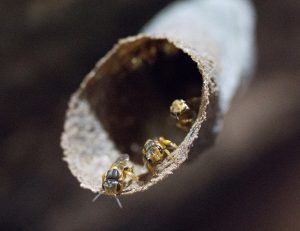
Solitary bee nest made of propolis.
Photo credit: Judy Griesedieck
If you are a food scientist…
If you study food as well as eat it, you might be intrigued by the potential of a propolis extract as a food preservative. The antiviral properties of propolis have been investigated with positive results in both fruit and vegetable juices (Nigbo et al. 2021).
If you are a violin maker…
If you are a maker of violins, you’re all about the resin-derived products. Stringed instrumentalists rub pine resin (they call it rosin) onto their bow hair, to create friction across the strings when they play (bees do not collect pine resin). You also may use bee propolis in the varnish for your instruments. Furthermore, you may actually be the guy who ended up in a scientific paper describing your propolis allergy in detail (Lieberman et al. 2002).
If you are an ancient Egyptian undertaker….
If you are an undertaker in ancient Egypt, you use propolis all the time to embalm mummies. Your brother, a local doctor, uses propolis for the living; for treating wounds, gashes, and toothaches.
If you are a dentist…
Dentists should totally read this recent study that shows promise that propolis, used in a mouthwash, could help reduce gingivitis (inflammation and bleeding in gums) (Kiani et al. 2021). Propolis has been long used in toothpastes, lozenges, creams and mouthwash, but research is ongoing to understand the benefits and mechanisms of its oral health support (Khurshid et al. 2017).
If you are still reading this article…
You are now a proponent of propolis. Pro-propolis. A proprolite. A proprolitizer. Scientists are still catching up on what the bees have always known, namely that tree resins are definitely worth collecting. We’re excited to continue following the scientists dedicated to unlocking the mysteries of this stickiness, further describing how it can be used in and out of the hive.
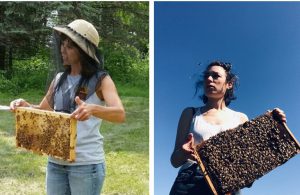
Authors
Becky Masterman led the UMN Bee Squad from 2013-2019 and currently alternates between acting as an advisor and worker bee for the program. Bridget Mendel joined the Bee Squad in 2013 and has led the program since 2020. Photos of Becky (left) and Bridget (right) looking for their respective hives.
References
- Borba, R., Klyczek, K., Mogen, K., Spivak, M. 2015 Seasonal benefits of a natural propolis envelope to honey bee immunity and colony health. J. Exp. Biol. doi:10.1242/jeb.127324
- Cortopassi-Laurino, M., Imperatriz-Fonseca, V., Roubik, D., Dollin, A. Heard, T., Aguilar, I., Venturieri, G., Eardley, C., Noguera-Neto, P.(2006) Global meliponiculture: Challenges and opportunities PARIS: SPRINGER FRANCE Apidologie, Vol.37 (2), p.275-292
- Hammad, M. (2018) Bees and beekeeping in ancient Egypt. Journal of Association of Arab Universities for Tourism and Hospitality. Vol 15 10.21608/ jaauth.2018.47990 www.researchgate.net/publication/335839271_BEES_AND_BEEKEEPING_ IN_ANCIENT_EGYPT
- Khurshid, Z., Naseem, M., Zafar, M. S., Najeeb, S., & Zohaib, S. (2017). Propolis: A natural biomaterial for dental and oral healthcare. Journal of dental research, dental clinics, dental prospects, 11(4), 265–274. https://doi.org/10.15171/joddd.2017.046
- Kiani, S., Birang, R. and Jamshidian, N. (2021), Effect of Propolis Mouthwash on Clinical Periodontal Parameters in Patients with Gingivitis: A Double Blinded Randomized Clinical Trial. International Journal of Dental Hygiene. Accepted Author Manuscript. https://doi-org.ezp3.lib.umn.edu/10.1111/idh.12550
- Lieberman, H. Fogelman, J., Ramsay, D. Cohen, D. (2002) Allergic contact dermatitis to propolis in a violin maker, Journal of the American Academy of Dermatology, Volume 46, Issue 2, Supplement 1, Pages S30-S31, ISSN 0190-9622, https://doi.org/10.1067/mjd.2002.106349.
- Lizzo https://genius.com/a/lizzo-missy-elliott-team-up-for-the-tempovideo
- Ningbo Liao, Liang Sun, Dapeng Wang, Lili Chen, Jikai Wang, Xiaojuan Qi, Hexiang Zhang, Mengxuan Tang, Guoping Wu, Jiang Chen, Ronghua Zhang (2021) Antiviral properties of propolis ethanol extract against norovirus and its application in fresh juices, LWT, Volume 152, 112169, ISSN 0023- 6438, https://doi.org/10.1016/j.lwt.2021.112169. (https://www.sciencedirect.com/science/article/pii/S0023643821013220)
- Sforcin, J. M. (2016) Biological Properties and Therapeutic Applications of Propolis. Phytother. Res., 30: 894– 905. doi:10.1002/ptr.5605.
- Shanahan, M. and Spivak, M. (2021) Resin Use by Stingless Bees: A Review. MDPI AG Insects (Basel, Switzerland), Vol.12 (8), p.719
- Silva-Carvalho, R., Baltazar, F., & Almeida-Aguiar, C. (2015). Propolis: A Complex Natural Product with a Plethora of Biological Activities That Can Be Explored for Drug Development. Evidence-based Complementary and Alternative Medicine, 206439-29.
- Simone M., Evans J., Spivak M. (2009) Resin collection and social immunity. Evolution 63: 3016-30222






